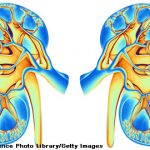NEW YORK (Reuters Health)—Using bisphosphonates for several years is associated with increasing brittleness and decreasing toughness of bone, according to a new review. “Long-term treatment with bisphosphonates can have negative side effects in some people because of their effects on bone toughness [toughness = the energy that bone tissue can absorb before cracking],” David B….

Bone Density Concerns: Guidance on Tackling Fracture Risk in CKD
Suggestions on how to assess risk and manage bone issues in chronic kidney disease patients are offered…
Zoledronate After Denosumab Does Not Fully Prevent Bone Loss
NEW YORK (Reuters Health)—In postmenopausal women and men treated for at least two years with denosumab, a single infusion of zoledronate given after denosumab discontinuation does not completely prevent bone turnover and loss, researchers say. Given the findings, “bone mineral density (BMD) should probably be higher than the current target for discontinuation of bisphosphonate treatment…
High-Dose Teriparatide with Denosumab Gives Bigger BMD Boost
NEW YORK (Reuters Health)—Adding high-dose teriparatide to denosumab therapy leads to substantially greater increases in bone-mineral density (BMD) than combination therapy with low-dose teriparatide, a new phase 4 study shows. “The combination of denosumab and teriparatide, particularly with high-dose teriparatide of 40 ug daily, may be of benefit to patients at very high risk of…

Dietary Calcium Intake Not Associated with Bone Loss
Postmenopausal women are often told to consume more than 1,500 mg of calcium daily to reach neutral bone balance. But new research suggests this recommendation should be revised, finding no connection between dietary calcium intake and postmenopausal bone loss…

Tracking Bone Deterioration in Patients with Ankylosing Spondylitis
Trabecular bone score and high-resolution peripheral quantitative computed tomography may be effective for evaluating bone impairment in patients ankylosing spondylitis (AS). Rheumatologists may be able to use these methods, complementary to dual-energy X-ray absorptiometry, to identify bone quality deterioration in AS patients.
Bone Mineral Density Most Important Determinant of Fracture Risk
NEW YORK (Reuters Health)—In what is believed to be the largest study investigating genetic and clinical determinants of osteoporotic fracture risk, only a genetic predisposition to low bone mineral density (BMD) had a potential causal role to play. “Notably, genetic predisposition to lower levels of vitamin D and estimated calcium intake from dairy sources were…
Romosozumab Improves Bone Mineral Density in Men with Osteoporosis
NEW YORK (Reuters Health)—Romosozumab improves bone mineral density (BMD) in men with osteoporosis, but safety concerns are holding up its approval in the U.S. Up to 2 million men in the U.S. have osteoporosis, and up to 13 million have osteopenia, researchers note in a report online June 20 in The Journal of Clinical Endocrinology…

Circulating microRNAs May Serve as Osteoporosis Biomarkers
New research suggests circulating hsa-miR-122-5p and hsa-miR-4516 may become diagnostic biomarkers for osteoporosis. The study found the presence of these microRNAs were associated with osteoporotic fragility fractures and reduced bone mineral density…
BMD Not a Reliable Predictor of Vertebral Fragility Fracture in Older Women
NEW YORK (Reuters Health)—Bone mineral density (BMD), particularly lumbar BMD, may not reliably indicate the presence of asymptomatic vertebral fragility fractures in post-menopausal women, new findings suggest. In a study online May 9 in Bone, Italian researchers found such fractures were common among women seen at an osteoporosis clinic, yet the vast majority had not…